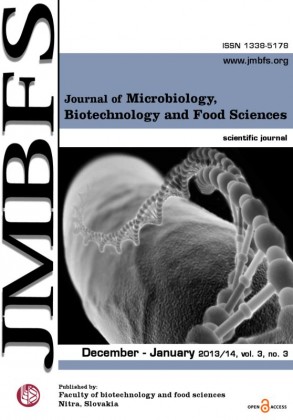OPTIMIZATION OF EXTRACELLULAR TANNASE PRODUCTION BY ASPERGILLUS NIGER VAN TIEGHEM USING RESPONSE SURFACE METHODOLOGY
Keywords:
Tannase optimization, response surface methodology, rotatable central composite design, Aspergillus niger Van Tieghem, fungal tannin acyl hydrolaseAbstract
Response surface methodology (RSM) was used to optimize the production of tannase by a newly isolate of Aspergillus niger Van Tieghem using rotatable central composite design (RCCD). This statistical optimization process was carried out involving four of quantitative growth parameters (variables), namely tannic acid concentration, nitrogen source concentration, initial pH of the medium and inoculum size. A mathematical model expressing the production process of tannase by submerged fermentation (SmF) technique was generated statistically in the form of a second order polynomial equation. The model indicated the presence of significant linear, quadratic and interaction effects of the studied variables on tannase production by the fungal isolate. The results showed maximum tannase production (580 U/50 ml medium) at 2% tannic acid, 4 g/l sodium nitrate, pH 4 and inoculum size of 5×107 spores/50 ml medium, which was also verified by experimental data.Downloads
Download data is not yet available.
Downloads
Published
2013-12-01
How to Cite
Abou-Bakr, H., El-Sahn, M., & El-Banna, A. (2013). OPTIMIZATION OF EXTRACELLULAR TANNASE PRODUCTION BY ASPERGILLUS NIGER VAN TIEGHEM USING RESPONSE SURFACE METHODOLOGY. Journal of Microbiology, Biotechnology and Food Sciences, 3(3), 202–207. Retrieved from https://office2.jmbfs.org/index.php/JMBFS/article/view/7031
Issue
Section
Microbiology
License
Copyright (c) 2013 Hamada Abou-Bakr, Malak El-Sahn, Amr El-Banna

This work is licensed under a Creative Commons Attribution 4.0 International License.
All papers published in the Journal of Microbiology, Biotechnology and Food Sciences are published under a CC-BY licence (CC-BY 4.0). Published materials can be shared (copy and redistribute the material in any medium or format) and adapted (remix, transform, and build upon the material for any purpose, even commercially) with specifying the author(s).

